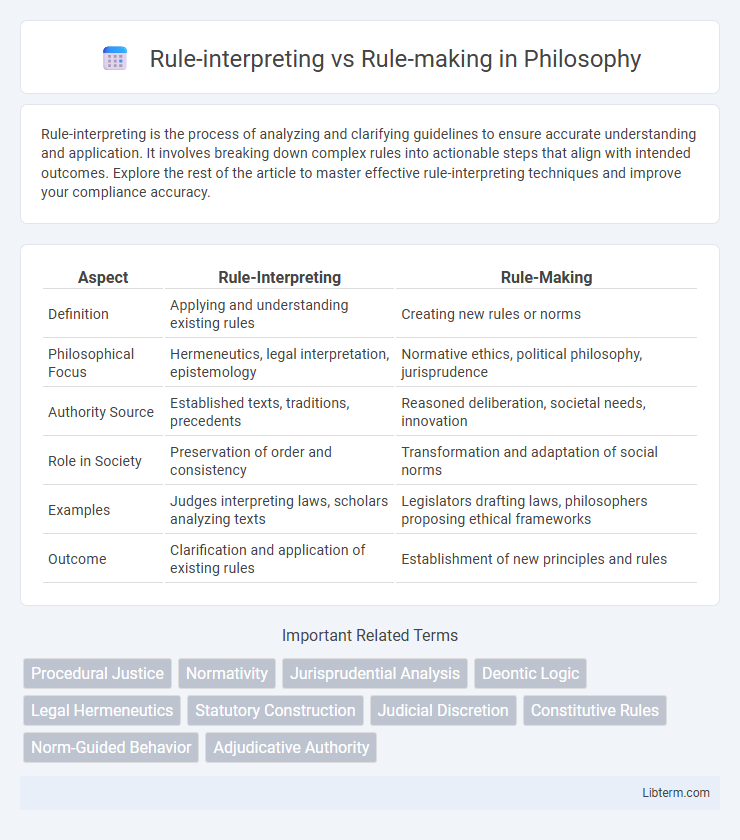Rule-interpreting is the process of analyzing and clarifying guidelines to ensure accurate understanding and application. It involves breaking down complex rules into actionable steps that align with intended outcomes. Explore the rest of the article to master effective rule-interpreting techniques and improve your compliance accuracy.
Table of Comparison
| Aspect | Rule-Interpreting | Rule-Making |
|---|---|---|
| Definition | Applying and understanding existing rules | Creating new rules or norms |
| Philosophical Focus | Hermeneutics, legal interpretation, epistemology | Normative ethics, political philosophy, jurisprudence |
| Authority Source | Established texts, traditions, precedents | Reasoned deliberation, societal needs, innovation |
| Role in Society | Preservation of order and consistency | Transformation and adaptation of social norms |
| Examples | Judges interpreting laws, scholars analyzing texts | Legislators drafting laws, philosophers proposing ethical frameworks |
| Outcome | Clarification and application of existing rules | Establishment of new principles and rules |
Defining Rule-Interpreting and Rule-Making
Rule-interpreting involves the judicial or administrative process of clarifying and applying existing laws or regulations to specific cases or contexts, ensuring consistent enforcement and understanding. Rule-making refers to the authoritative creation or modification of legal norms and regulations by legislative bodies or administrative agencies to address emerging issues or policy goals. Both processes are fundamental in maintaining legal order, with rule-making establishing the framework and rule-interpreting ensuring practical implementation.
Historical Context of Rule Creation and Interpretation
Rule-interpretation involves applying established legal principles to specific cases, often evolving through judicial decisions and precedents, while rule-making traditionally refers to the legislative or administrative process of drafting formal regulations or statutes. Historically, rule-making has roots in sovereign authorities or legislative bodies enacting laws, whereas rule-interpretation emerged through common law traditions where courts clarified and adapted statutes to new circumstances. Key historical milestones include the Magna Carta influencing rule-making by limiting royal authority, and landmark court rulings such as Marbury v. Madison solidifying judicial interpretation as a critical mechanism in legal systems.
Key Differences Between Rule-Interpreting and Rule-Making
Rule-interpreting involves analyzing and applying existing regulations to specific cases, ensuring compliance and consistency within the legal framework. Rule-making refers to the process of creating new regulations or policies, which involves drafting, proposing, and formalizing rules that govern future conduct. Key differences include the scope of authority--interpretation enforces current laws while rule-making establishes new standards--and the level of discretion granted to administrative agencies or governing bodies.
The Role of Rule-Makers in Governance
Rule-makers hold a critical position in governance by establishing laws and policies that shape societal behavior and ensure order. Their decisions influence economic development, social justice, and public safety through the creation of clear, enforceable regulations. Effective rule-making requires balancing diverse stakeholder interests while anticipating the long-term impact of policies on governance structures.
Functions of Rule-Interpreters in Legal Systems
Rule-interpreters in legal systems analyze statutes, precedents, and regulatory texts to clarify ambiguous language, ensuring consistent application of laws across cases. They play a critical role in judicial decision-making by resolving conflicts between rules and adapting legal principles to evolving societal contexts. Their function maintains legal stability and predictability by interpreting rules without creating new laws, distinguishing their role sharply from that of rule-makers such as legislators.
Importance of Separation Between Rule-Making and Rule-Interpreting
The separation between rule-making and rule-interpreting is crucial for maintaining checks and balances within governance systems, ensuring that legislative bodies create laws while judicial entities interpret them without overreach. This division prevents the concentration of power, upholds the rule of law, and promotes accountability by assigning distinct roles to policymakers and adjudicators. Preserving these boundaries enhances transparency, protects individual rights, and fosters public trust in legal and regulatory processes.
Case Studies Illustrating Both Concepts
Case studies of rule-interpreting often involve judicial decisions, such as the U.S. Supreme Court's interpretation of the Constitution in Brown v. Board of Education, which clarified the application of existing laws. Rule-making examples include administrative agencies like the Environmental Protection Agency (EPA) creating regulations to enforce statutory mandates under the Clean Air Act. These cases demonstrate the distinct functions where courts interpret legal principles, while agencies develop detailed rules to fill legislative gaps.
Challenges in Balancing Rule-Making and Rule-Interpreting Powers
Balancing rule-making and rule-interpreting powers presents challenges such as maintaining clear separation of powers while ensuring effective governance. Rule-making authorities must create adaptable regulations, whereas interpreting bodies face the difficulty of applying these rules consistently across diverse cases. Conflicts often arise over judicial activism versus legislative intent, complicating the equilibrium between policy creation and legal interpretation.
Impacts on Policy and Society
Rule-interpreting bodies, such as courts, shape policy implementation by clarifying legal boundaries and resolving ambiguities, ensuring consistent application of laws across diverse cases. Rule-making entities, primarily administrative agencies, directly influence policy by creating regulations that fill legislative gaps, often responding swiftly to societal needs and technological advancements. The dynamic between rule-interpretation and rule-making creates a balance where judicial review safeguards against overreach, while precise regulations promote societal order, economic efficiency, and public trust.
Future Trends in Rule-Making and Rule-Interpreting
Future trends in rule-making emphasize adaptive frameworks that integrate artificial intelligence and data analytics to enhance regulatory precision and responsiveness. Rule-interpreting is increasingly leveraging machine learning algorithms to predict judicial outcomes and streamline legal reasoning processes, promoting consistency and efficiency. Emerging technologies drive a shift toward dynamic, transparent governance models where real-time data influences both the formulation and interpretation of rules.
Rule-interpreting Infographic

 libterm.com
libterm.com